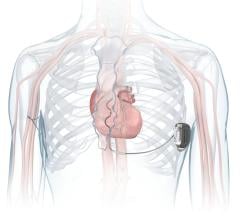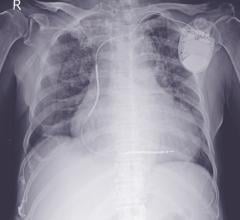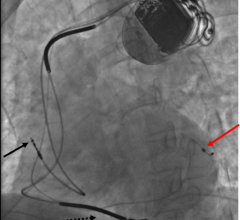May 1, 2008 - High-amplitude electrogram T-wave alternans often precedes spontaneous ventricular tachycardia (VT) and ventricular fibrillation (VF) in humans, and can be detected by measuring stored data directly from implantable cardioverter-defibrillators (ICDs), according to a new study published in the May issue of HeartRhythm, the official journal of the Heart Rhythm Society,
ICDs deliver electrical pulses to stop VT/VF after it has started. Study findings may permit ICDs to warn patients who are about to have VT/VF and may ultimately permit ICDs to deliver sequences of electrical pacing pulses that prevent the onset of VT/VF.
Characterized by a very fast and abnormal heart rate, VT is a serious condition that warrants immediate treatment and can lead to VF and sudden cardiac arrest. T-wave alternans is a measure of cardiac electrical instability.
Previous studies have used advanced signal processing techniques to measure T-wave alternans from the routine surface electrocardiogram and predict whether patients are at sufficient long-term risk of VT/VF to warrant implantation of an ICD. Unlike previous studies, the new study led by Charles Swerdlow, M.D., FHRS, Cedars Sinai Medical Center in Los Angeles, CA, looks for short-term predictors of spontaneous VT/VF using electrical signals recorded from ICD electrodes. These electrodes are wires that are permanently implanted in the heart and attached to the ICD.
This is the first study to measure T-wave alternans in humans directly from ICD recordings. To make these measurements, Dr. Swerdlow's team first had to develop and validate a new simple averaging method, suitable for use in an ICD, to measure T-wave alternans from short segments of ICD electrical signals. "Using this method, we found that high-amplitude T-wave alternans occurs frequently just before the onset of spontaneous VT/VF and only rarely at other times,"? said Dr. Swerdlow.
Using this new method, T-wave alternans from ICDs can be measured continuously, enabling the detection of high-amplitude T-wave alternans, which could be used to predict the onset of VT/VF. According to Dr. Swerdlow, the long-term goal of this research is to develop ICD technology that continuously and automatically assesses T-wave alternans for the purpose of warning patients before the onset of VT/VF or even initiating pacing algorithms to prevent VT/VF.
For more information: www.heartrhythmjournal.com


 September 05, 2024
September 05, 2024 








